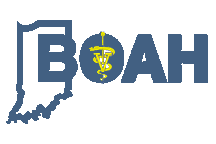Swine Health Communication Guidelines
July 2012 Printable Version
The Indiana Swine Health Advisory Committee's scientific subcommittee on PRRS has worked collaboratively with the Indiana State Board of Animal Health (BOAH) to assess the value and practicality of sharing information among neighboring swine producers regarding their herds' PRRS exposure status. Based on increasing risk from new, more virulent PRRS strains and availability of improved and more affordable diagnostics and prevention methods, BOAH and the scientific subcommittee recommend the following guidelines for good neighbor action in the event of a change to PRRS exposed status.
The Indiana Swine Health Advisory Committee suggests pork producers notify neighbors of their current PRRS exposure status according to the following recommendations:
Inform swine owners within 2 miles of the exposed animals
Emphasis should be placed on sites where swine are maintained 12 months a year
Notification should be made to the pig owner and/or site owner on an annual basis
BOAH can assist with identifying neighboring sites
Exposure Categories
Naive (negative) (see AASV definition and document on Gilt Acclimation)
Known Exposed (positive) (see AASV definition and document on Gilt Acclimation)
"Exposed" includes: Natural exposure, and use of live virus inoculation (LVI) and/or modified live virus inoculation (MLV)
By opening lines of communication among producers in an area, the sharing of health status information will benefit all Hoosier pork producers and the industry, as well as give neighbors the opportunity to make protective management decisions (such as use of modified live virus to build herd immunity).
These guidelines apply only to disease issues that have no human health consequences, such as PRRS, and serve as a means to improve disease management at a community level.
Future notification should be done in the following circumstances:
Change to PRRS Exposed Status
Owner of a herd with a change to PRRS exposed status should share status information with pork producers within 2 miles
Notification should include status change due to both intentional and unintentional exposure
Neighbors should be informed of circumstances of exposure (natural or introduced)
Use of PRRS Management Practice
Owners of pigs should share status information with pork producers within 2 miles of their facility when a live PRRS exposure method is used
Field strain (live virus inoculation or natural exposure) or modified live PRRS vaccination product
Movement of Known Exposed Swine
Owners of exposed pigs that are being moved should share status information with pork producers within 2 miles of the destination site for the exposed animals
Notification should occur as soon as practical upon learning of change in status
When movements are made on a regular basis to a specific site and the overall status of the incoming animals has not changed (ie, the site continuously receives only exposed animals) annual notification is sufficient
Options for Gilt Acclimation and Isolation with Emphasis on PRRS Management
The Indiana Swine Health Committee's scientific subcommittee on Porcine Reproductive and Respiratory Syndrome (PRRS) has collaborated with the Indiana State Board of Animal Health to identify options for consideration in managing the PRRS status of replacement gilts. Advantages and disadvantage of various methods are described below. Terminology used for classifying PRRS exposure status is consistent with the definitions jointly developed by the American Association of Swine Veterinarians (AASV) and the United States Department of Agriculture (USDA) PRRS Coordinated Agricultural Project and approved by the AASV Board of Directors on March 9, 2010.
For purposes of this document, PRRS exposure status is the only status recognized and is defined as below:
Exposure Status: naive (negative) or exposed (positive) based on serological testing:
Naive-no evidence of exposure to field or vaccine viruses, assessed by absence of antibodies to virus in samples tested.
Exposed-evidence of exposure to field or vaccine viruses, assessed by presence of antibodies to virus in samples tested.
Until a differential diagnostic test or differentiable vaccines become available, no clear distinction is possible between results that are serologically positive due to live or killed vaccine usage versus those positive due to wild-type virus; thus no distinction is made (AASV).
The complete, printable document is available here.
